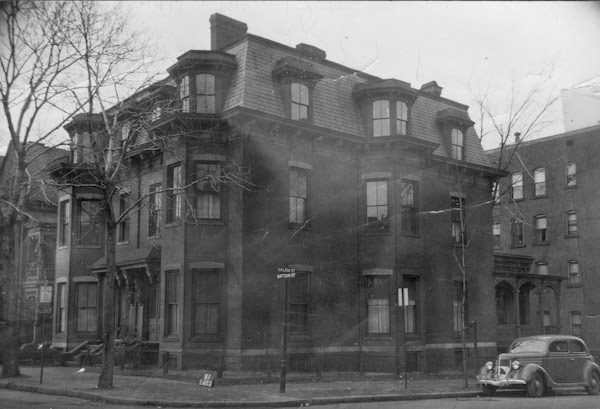The twin houses at 50-52 Mattoon Street in Springfield, around 1938-1939. Image courtesy of the Springfield Preservation Trust.
The scene in 2018:
These two adjoining houses at 50 (left) and 52 (right) Mattoon Street in Springfield were previously featured in an earlier post, which shows the properties from a different angle. As discussed in that post, these houses were built around 1872-1873, and they were among the first of the Victorian-era townhouses to be built here on Mattoon Street. These early houses tend to have the finest architecture, as the Panic of 1873 – and subsequent economic recession – curtailed development on the street and led to less expensive, less ornate houses during the later 1870s.
The house in the foreground, at 52 Mattoon Street, was originally the home of furniture dealer Julius A. Eldridge and his wife Catherine. However, they were evidently not here for very long, because by 1880 it was owned by Henry W. Chapin, a patent solicitor of the firm of Chapin & Co. That year’s census shows him living here with his wife Sarah, along with three daughters and a son, William, who worked for his father’s company. The census also indicates that their neighbor at 50 Mattoon Street was Charles P. Lyman, a veterinary surgeon who lived here with his wife Mary, three young children, and two servants.
The large townhouses on Mattoon Street had been built as single-family homes, and were generally used as such for the first few decades. However, this began to change by the turn of the 20th century, as the street became more middle class. Both 50 and 52 Mattoon were still single-family homes at this point, but many of the neighboring ones had already been converted into rooming houses. The 1900 census shows Horace Eddy renting 52 Mattoon, where he lived with his wife Martha, their son Arthur, and Arthur’s wife Florence and son Lawrence. Their neighbor at 50 Mattoon was Thomas Keating, an Irish-born machinist for Gilbert & Barker, and he lived here with his wife Margaret and their three children.
By the time the first photo was taken in the late 1930s, many of the houses on the street had become rooming houses, including both of these properties. The 1940 census shows that 52 Mattoon was rented by Alice LeBlanc, who in turn rented rooms to 11 lodgers here. At the same time, 50 Mattoon was owned by Lester Hammond, a city policeman whose wife Fannie was listed as a rooming house proprietor. There were only two lodgers staying here during the census, although they likely would have had room for many more, as indicated by the number of people living next door.
Mattoon Street would continue its decline into the second half of the 20th century, and by the early 1970s most of the houses were in poor condition. The state’s MACRIS database listing for 52 Mattoon, which was written in 1971, notes that the house “is the only existing structure on the street to be rehabilitated and stands as an example of excellence for other owners to strive for.” Three years later, the street became part of the Quadrangle-Mattoon Street Historic District on the National Register of Historic Places, and over time the other historic houses have been restored. Today, there is very little difference between these two photos, and Mattoon Street survives as one of the best-preserved historic streets in Springfield.


